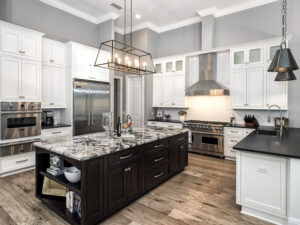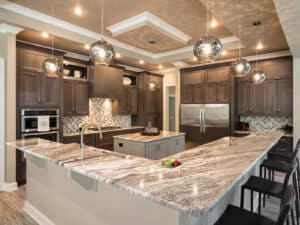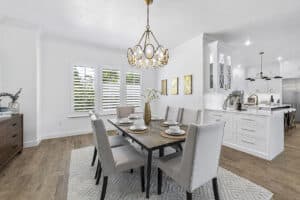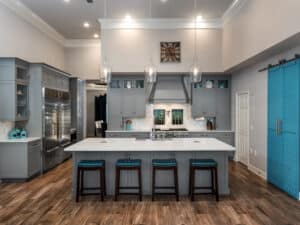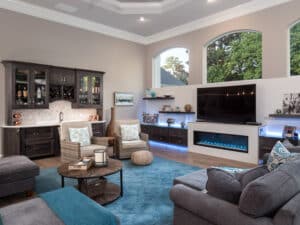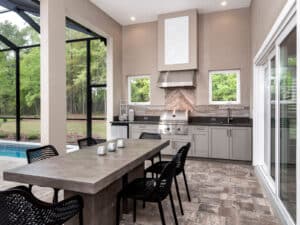Top Tips for Connecting Kitchen and Living Room Designs
November 2, 2022
Whether you are embarking on a kitchen remodel or a whole first-floor re-design, your remodeling expert will help you create a design that fits your home and family. This includes integrating the style and functionality of your kitchen design with surrounding spaces like a family room or living room. Connecting these key living areas is especially important in open-plan kitchens that allow for easy movement between the kitchen, dining, and living rooms. With the latest kitchen cabinet styles, flooring options, lighting, and more it’s easy to create blended living spaces that balance functionality and style.
Start by establishing a plan for your first floor based on your requirements. Create a layout that works for you, establish the flow of movement between different rooms, and include storage to keep you organized. Then incorporate materials, textures, colors, and accessories that connect your first-floor living spaces to build a cohesive style.
Plan Your Ideal Layout
The first step is to create a layout that works for your home and family. The layout is the foundation of any kitchen design, so get this right and everything else will fall into place. Open-plan designs are popular for today’s multi-functional kitchens, as they allow for integrated living where kids can play in the family room while you cook dinner nearby. They also make for perfect parties since guests always follow the smell of food and drink and migrate to the kitchen anyway!
Even if the open plan doesn’t work for you, consider how your kitchen and adjacent living spaces fit together, look at the purpose of each space, and plan for the flow of traffic from one room to the next. You may want your family room to feel like an extension of the kitchen, but still maintain a separate first-floor home office or a living room intended for quiet relaxation.
When considering your layout, it helps to first examine your home and decide what you like and don’t like about it. Get the family together and figure out what you want to change to create a layout that enhances the way you live and work in your home. Bring these ideas with you when you meet your kitchen design professional. An experienced design expert can take on board your ideas and bring an innovative approach to finding the perfect plan for your home remodel.
Create Zones for Work and Relaxation
Part of creating your ideal layout is planning what activities take place where. Creating clear zones for what you plan to do in your kitchen and adjacent living spaces allows everyone to peacefully coexist by including storage, seating, and workspace where you need them.
It also allows for some essential separation of activities, even in the most open-plan design. This means you can prepare dinner without tripping over kids doing homework or get appetizers ready while guests sit and chat nearby. Clear zones for work, dining, entertaining, and more are key to having an integrated first-floor design that functions efficiently. Make sure your kitchen design includes a hood with sufficient ventilation, so smoke, odors, and steam do not interfere with adjacent entertainment spaces.
Manage the Flow of Traffic
One way to manage your zones is by separating them with an island or peninsula. An island is a distinct focal point of any kitchen design and often the place where everyone gathers to do homework, have a snack or prepare food. The island is also a natural place to separate zones by including a sink or cooking area on one side while the other is reserved for casual dining.
Choose the location of your storage, appliances, and countertop surfaces according to your layout and zones. For your cooking or food prep zone, this could incorporate a knife drawer, custom pullouts for spices and cooking utensils, and deep drawers for pots and gadgets. If you love to bake, create a specialized baking zone with a mixer lift and custom storage for baking essentials.
The other side of your island can cater to kids grabbing a quick snack, your morning breakfast routine, or sharing a glass of wine with friends. Include barstools as well as access to a beverage bar or under-counter refrigerator and a drawer packed with healthy snacks for the kids. Countertop surfaces also help to separate zones, like this kitchen design with a wood countertop section for dining next to a quartz countertop for food prep.
If you don’t have space for an island, then a peninsula can serve the same purpose. Or, in a spacious kitchen design include more than one island, which allows you to designate one for work and the other for entertaining, each customized with storage and features to enhance your kitchen.
In an open-plan first-floor design, you can even use furniture like a couch or bookshelf to delineate work areas from entertainment and relaxation zones. These items still give you the full effect of an open-plan design while offering some separation.
Allow for Noise Control
Open, or even semi-open, plan designs are great, but they also mean there is limited privacy and protection from noise. This may not matter when you are home alone, but it could be a problem if the kids are watching a movie while you work in your home office or have a glass of wine with a friend in the kitchen.
One way to address this is to separate areas where you want more privacy or noise control with pocket doors or glass doors. Pocket doors installed between a kitchen/dining room and a family room allow the space to be opened up or closed off when it suits you. Glass or metal doors are another option that provide some separation and noise control, while still allowing light to shine through.
Light Up Your Spaces
A cohesive, layered lighting plan is essential to your entire home. In a kitchen design, it is especially important to have task lighting where you need it so you can easily read recipes and chop vegetables. Lighting also allows you to set the tone for an intimate dinner party, create a space to wind down in the evening or highlight decorative items on open shelves.
In an open-plan kitchen design, lighting is even more important as your light fixtures must take you from preparing meals to relaxing with a glass of wine in the evening. Dimmer switches, or even better smart lighting controlled from an app, allow you to seamlessly move from morning to night and set the tone for your activity and mood from one area of your home to the next.
The style and material of your light fixtures are also important to consider since essential lighting doubles as a style accessory, such as pendants and chandeliers in trendy materials and colors. This is also an excellent way to connect your kitchen and living room styles, by selecting light fixtures that bring the spaces together. Alternatively, a single light fixture can establish a separate zone, such as a distinctive floor lamp in a quiet corner used for reading or relaxation.
Create a Smart Home
With today’s smart homes, everything can be controlled from your phone, tablet, or watch with ease. This includes activities from looking up and following recipes on your tablet to controlling appliances and tracking food supplies with a smart refrigerator.
Technological innovations also make it simple to set up integrated entertainment systems where music can be played throughout your first floor, which is ideal when you are entertaining. Most importantly, it can also be turned off (or volume adjusted) in specific zones when you need more peace in one part of your first-floor home design.
If you love to watch television while cooking, position the family room TV so it is visible from your kitchen island or set up a second screen for the kitchen only. Make sure you have comfortable seating in both the kitchen and adjacent living room where you and guests can watch football or the Thanksgiving parade while you prepare snacks and drinks.
In today’s digital world, safe storage and charging for electronics are essential. Include charging points in your kitchen and living room and consider adding a custom storage drawer for electronics with built-in charging.
Establish a Color Scheme
Choosing a color palette allows you to give your first-floor rooms a cohesive feel. This doesn’t mean every room has to be the same but linking rooms with color draws the eye and creates a natural flow between different spaces. What does this look like in practice?
- You could give your first floor a neutral base color palette that creates a fluid style.
- Or choose different shades that belong to the same color family, linking them but varying the tone to signify movement from one room to the next.
- Pick accessories in the same accent color to visually connect the spaces, such as the vibrant blue tones found in this kitchen design’s barstools, tile accents, barn door, and banquette seating, paired with the living room’s rug and throw pillows.
- Today’s high-quality wood cabinetry allows you to choose cabinets for a beverage bar or entertainment center installed in your living room that matches your kitchen cabinets.
Small, enclosed spaces like a powder room or home office are ideal rooms to differentiate with color. Create a unique powder room painted in a bold color or with patterned wallpaper. For a home office, you may want to establish a cozy atmosphere in a darker shade or go for a modern monochrome vibe.

Bring in Textures
Textures are another ideal way to enhance your home’s style and subtly connect rooms. Layering textures brings depth to your home’s design aesthetic and allows you to take your room from boring to cozy with ease. Textures can be introduced with everything from your choice of flooring material to wall or window treatments, artwork, accessories, and rugs. Textures are also an ideal way to bring depth to a neutral color scheme. For example, layering white or off-white materials in different textures transforms a neutral room, like this cozy living room design.
There are many ways you can incorporate textures in your design:
- Choose a countertop material for your kitchen design that also works for your living room’s fireplace.
- Select storage containers or accessories in matching materials, such as a basket to store vegetables on the countertop with a larger version for the living room to hold throw blankets or cushions.
- Choose window treatments that continue the same theme whether that is sheer curtains or wood shutters. The same goes for soft textiles such as rugs, pillows, or blankets.
- Metallic accents such as light fixtures, cabinet hardware, and kitchen island barstools can all be used to connect your rooms when you select items in the same material and finish.
- Flooring is an ideal way to bring rooms together, especially in an open-plan design. Hardwood is beautiful and timeless, but not as well suited to a kitchen design that must withstand constant foot traffic and moisture. Luxury Vinyl Plank (LVP) is an alternative that gives you the look of hardwood and even mimics the texture but is well suited to all living spaces.
Connect with the Outdoors
Your dining and entertainment spaces don’t end at the back door, so remember to include your outdoor spaces in design planning. Make your outdoor kitchen design, dining area, and seating a natural extension of indoor rooms with large doors and windows. Choose materials that suit the outdoor environment but that reflect your home’s style. Make sure you have comfortable seating plus lighting and a continuation of your entertainment system so family and guests can enjoy relaxing outdoors.
A cohesive first-floor home remodel lets you have it all with a layout, storage, and style that connects the kitchen and living spaces. Find the layout that works for your home and family, then add storage and work zones for all your requirements. Create a fluid style with materials, colors, textures, and accessories that connect these spaces and create a multi-functional first floor where you can cook, work, and relax.

